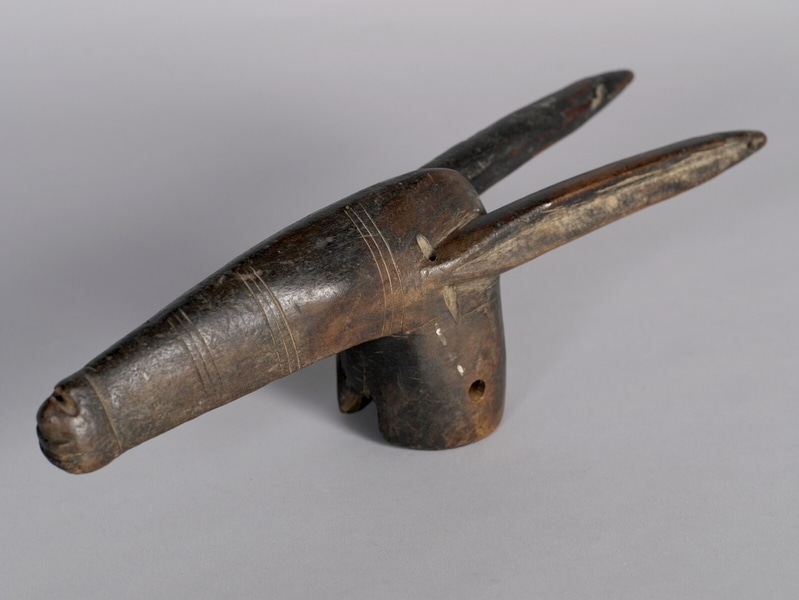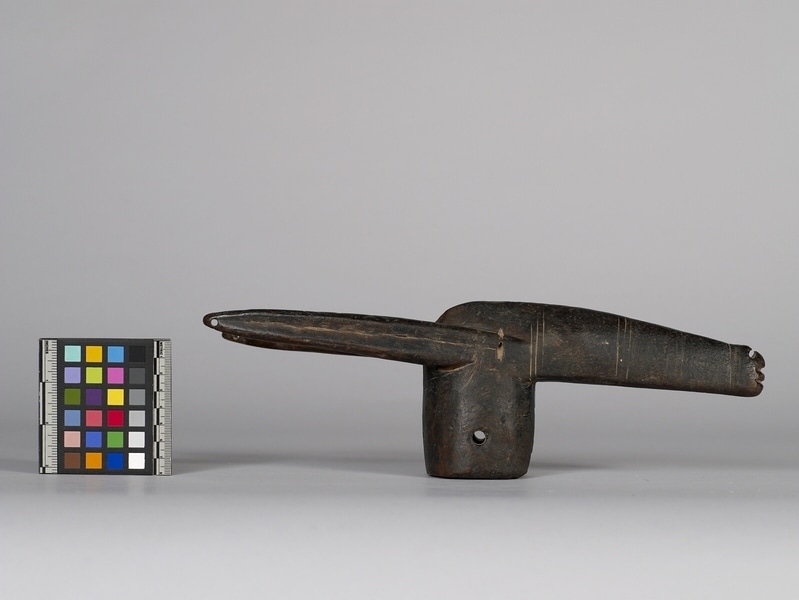String Puppet Item Number: Ag74 from the MOA: University of British Columbia


Description
Wooden marionette head of an antelope. No eyes; long, horizontal snout. Long, thin ears extend horizontally backward and have a hole at the tip. Incised with three sets of triple bands around the snout. Short, thick, hollow, cylindrical neck has a hole at either side.
History Of Use
Hand-carved by the Numuw blacksmith clan of the Segou, this puppet (sogo bò) likely belonged to the kamalen ton, a local village youth association, where it would have been painted and paraded around on a mobile stage. The sogo bò puppets are often used as the head for the larger sogobaw (big beasts), that are constructed by wooden pole structures covered in clothes to conceal the puppeteers inside. The sogobaw usually depict antelope, buffalo, birds, cows, or goats. The dances performed are symbolic of antelope in the way they move, and what they represent to the Bamana peoples. Sogobaw are also used by youth to carve a reputation for themselves as entertainers or satirists by creating a new character, a new story or new critique of their peoples. Often puppets were recycled from year to year and re-painted or re-oiled a few weeks before the celebration. It would have been activated twice a year by the kamalen ton at annual festivals, which were determined by the agricultural and fishing cycles. At these festivals, puppeteers, dancers, singers, and drummers of the kamalen ton showcase a series of puppet scenes, each with its own associated short song and dance. As each set of characters enters the dance area, they are paraded and animated in a counterclockwise direction on mobile stages. The dance continues and is punctuated by pauses at specific intervals, such as in front of elders, the lead singer, or honoured guests. At one point, this antelope form may have been affixed with cloth or grass fringe.
Iconographic Meaning
The banded lines spanning the length of the puppet’s snout may be indicative of the virtues the kamalen ton, a youth association, attempted to imbue onto the youth of Mali. With a mouth fixed shut, this puppet may embody virtues such as discipline, silence, or awareness.
Specific Techniques
Puppets are carved using m’peku wood, which grows around Bamana villages. To harvest the wood, cowrie shells are often given to trees as offerings to the spirit Nyama, which exists in all living natural things; the spirit will also live in the wood of the puppet. Afterwards, the puppet is coated in sá or shea oil to protect it.
Item History
- Made in Segou, Mali
- Owned by Eric Sonner before October 22, 1990
- Received from Eric Sonner (Donor) on October 22, 1990
What
Who
- Culture
- Bamana
- Previous Owner
- Eric Sonner
- Received from
- Eric Sonner (Donor)
Where
- Holding Institution
- MOA: University of British Columbia
- Made in
- Segou, Mali
When
- Ownership Date
- before October 22, 1990
- Acquisition Date
- on October 22, 1990
Other
- Condition
- fair
- Accession Number
- 1433/0088